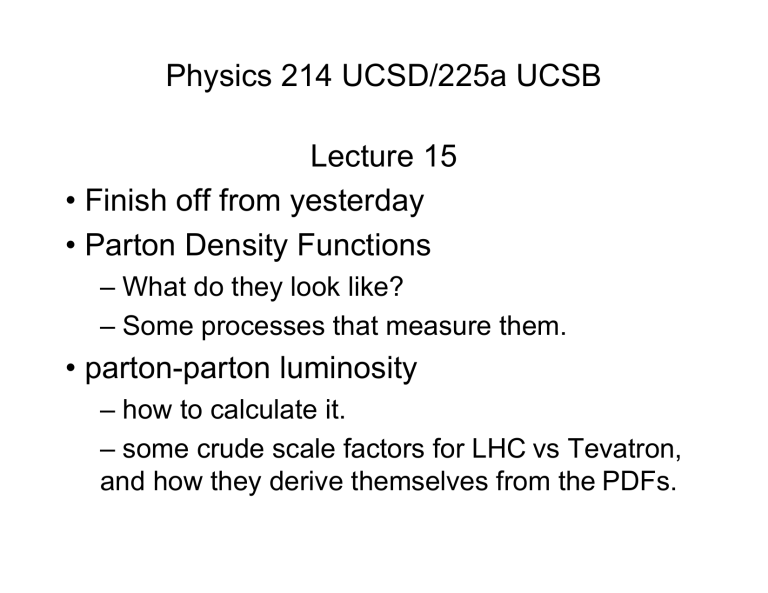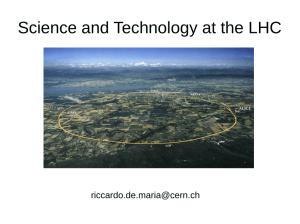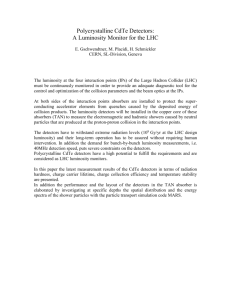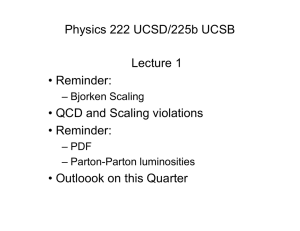Physics 214 UCSD/225a UCSB Lecture 15 • Finish off from yesterday

Physics 214 UCSD/225a UCSB
Lecture 15
• Finish off from yesterday
• Parton Density Functions
– What do they look like?
– Some processes that measure them.
• parton-parton luminosity
– how to calculate it.
– some crude scale factors for LHC vs Tevatron, and how they derive themselves from the PDFs.
The parton picture of the proton
• Proton is made up of some set of partons.
– Some of which are charged
– Others aren’t.
• Each parton carries a fraction, x, of the momentum.
Energy
Momentum
Mass
• All fractions add up to 1:
Proton
E p p
M
L
T
= 0
Parton xE x p
L p
T
= 0 xM
"
i
!
dx xf i
( x )
=
1
Incoherence assumption (1)
• “Natural” frame of reference for scattering is the center of mass frame of e-p.
• In that frame, the valence quarks are relativistic => time dilation guarantees that gluon exchange between them (i.e. in the proton restframe) are slooooow.
– Note: This is no different than the fact that an unstable particle lives longer when viewed from a frame in which it is moving with speed close to c.
Incoherence assumption (2)
• dt during which the virtual photon interaction takes place is << than the time for the partons to interact with each other.
⇒ We can add probabilities for interacting with each parton, rather than the amplitudes.
⇒ This is referred to as the incoherence assumption , and implicit in our use of f i
(x):
"
i
!
dx xf i
( x )
=
1
Recap of parton structure function
• There is only one F(x).
• It is made out of the incoherent sum of probabilities for finding a given type i of parton at a given x in the proton:
2 xF
1
( x )
=
F
2
( x )
=
!
e i
2 xf i
( x ) i
• The experimental problem is thus to extract f i a large variety of measurements .
(x) from
• For deep inelastic e-proton, the gluon structure function can be obtained from the requirement that it all adds up. Gluons are the leftovers.
Simple Example for determining structure function for quarks.
• Compare e-proton with e-neutron deep inelastic scattering.
⇒ This gives us F ep and F en structure function.
1 x
F ep =
!
"
2
3
$
%
2 ( u p ( x )
+ u p ( x )
)
+
!
"
1
3
$
%
2 ( d p ( x )
+ d p ( x )
)
+
!
"
1
3
$
%
2 ( s p ( x )
+ s p ( x )
)
1 x
F en =
!
"
2
3
$
%
2 ( u n ( x )
+ u n ( x )
)
+
!
"
1
3
$
%
2 ( d n ( x )
+ d n ( x )
)
+
!
"
1
3
$
%
2 ( s n ( x )
+ s n ( x )
)
We then assume that all sea quark contributions are the same for ep and en. And the valence quark ones are related by isospin.
We then assume that all sea quark contributions are the same for ep and en. And the valence quark ones are related by isospin. u p = d n = u(x) d p = u n = d(x) s p = s n = s(x) u - ubar = u d - dbar = d v v
=>
1
F
2 ep ( x )
= x
1 x
F
2 en ( x )
=
1
9
[
4 u v
( x )
+ d v
( x )
]
+
12
S ( x )
9
1
9
[ u v
( x )
+
4 d v
( x )
]
+
12
S ( x )
9
Here S(x) refers generically to sea quarks, while 12/9 accounts for the sum of e 2 for u,d,s and their anti-quarks in the sea.
Note: charm and beauty is ignored in this discussion.
Some observations
• Since gluons create the sea q-qbar pairs, one should expect a momentum spectrum at low x similar to bremsstrahlung:
=> S(x) -> 1/x as x -> 0 at fixed Q 2 .
=> F en /F ep -> 1 as x -> 0
=> F en /F ep -> (u v
+ 4d v
)/(4u v
+ d v
) as x -> 1
• Experimentally, we observe:
F en /F ep -> 1 as x -> 0 as expected.
F en /F ep -> 0.25 as x -> 1 => u v
appears to dominate at high x.
• This means that up quarks dominate in proton while down quarks dominate in neutron at large x.
• The dominant valence quark dominates at large x.
• Fitting structure functions of proton and anti-proton is an industry. There are 3 independent groups doing it, using a large number of independent measurements including ep,en, neutrino-p, neutrino-n, photon cross section, DY, W forward-backward asymmetry etc. etc. etc.
• This is very important “engineering” work for the LHC !!!
We’ll have a seminar on this next week!
For now, let’s just look at some examples.
Proton
To account for 2 up for every down in proton !!!
Up has larger momentum than down quark.
Proton
Sea dominates at low x
1e-2 * 7TeV =70GeV
A 14TeV collider can be pp instead of ppbar !!!
Sea violates isospin at large x?
Gluons dominate at low x .
To set the scale, x = 0.14 at LHC is 0.14 * 7TeV = 1TeV
=> The LHC is a gluon collider !!!
Parton Model and Bjorken Scaling
We introduced two definitions for “x”.
One from e-p scattering: x
=
!
q 2
2 p
" q
=
1
#
And one from the parton model momentum fraction.
Section 9.2 in H&M shows that these are actually the same. f
2 i (
!
)
= "
%&
$
1
#
1 x
!
()
'
Is the F
2
structure function for the ith parton, that has a momentum fraction x.
As we sum over all partons: F
2
(
!
)
=
#
i
"
dxe i
2 f i
( x ) x
$
'(
& x
%
1
!
*+
)
The δ -function here means that the virtual photon must have just the right x to be absorbed by a parton with momentum fraction,x, of the proton.
Ways to measure PDFs
• The HERA collider collides electrons on protons.
This has produced a wealth of data.
– Including measurement of the charm content of the proton by reconstructing charmed mesons in the final state.
• In addition, hadron collider data from these processes are used to fit PDFs:
Most sensitive probe of d/u momentum ratio in proton at Q 2 ~M 2
W
.
Drell-Yan at Z pole from CDF
Different detection topologies:
Central-Central,
Central-forward,
Forward-forward
The differences are small but noticeable.
DY vs rapidity from CDF for two different PDF sets.
In both cases the total cross section is normalized to what’s seen in data.
PDF uncertainty significant for large rapidity.
Note:
500GeV => x=0.5
Inclusive Jet production at CDF vs pT for different rapidity ranges.
Yellow = experiment systematics
Black = experiment data & stats
Red = PDF uncertainty
Prompt photons at D0
Comparing e-proton data with PDFs.
Top = state of the art ~2001, includes early HERA data.
Bottom = history for one set of PDFs compared to 2001 data.
pp (or ppbar) collision
• Use Feynman diagrams to calculate σ for collision of partons of type i and j at CM energy E. Call this:
!
ˆ ij
( )
"
!
ˆ ij
( )
• To get the cross section of pp, I then need to integrate over all possible x i
,x j
with:
ˆ
= x i x j s
• In other words, a pp collider is a “broadband collider” spanning a wide range of CM energies, as well as types of colliding partons (!), with propabilities given by the product of PDF of the types of particles colliding.
=
Let’s explore this formally
d
!
( pp
" f d ˆ
)
=
& ij
!
ˆ ij
( ) % 1
0
1
0
% dx i dx j f i
( x i
) f j
( x j
)
#
(
ˆ $ x i x
& ij
!
ˆ ij
( )
% 1
0
% 1
0 dx i dx j f i
( x i
) f j
( x j
)
#
(
'
) 1
$ x i x j s
+
*
, j s
)
=
( s d
!
pp
" f d
-
<- to save some writing.
)
=
& ij
!
ˆ ij
-
( ) d
!
( pp
" f d
-
)
=
& ij
!
ˆ ij
-
( )
% 1
0
% 1
-
% 1
0 dx i dx i dx j f i
( x i
) f j
( x j
)
#
(
'
) 1
$
x i f i
( x i
) f j (
'
)
x i
+
*
, x i
x j
+
*
,
Cross section as a function of parton-parton Luminosity
d
!
( pp
" f d
#
)
=
+ ij
!
ˆ ij
#
( )
* 1
# dx i
# x i i f i
( x i
) f j %
$
&
# x i
(
'
) d
!
( pp
" f d
# dL ij d
#
=
1
+
1
, ij
)
* 1
#
=
+ ij dL ij d
#
!
ˆ ij
( ) dx x .
-
/ f i
( x ) f j %
$
&
# x
(
'
) + f i %
$
&
# x
(
'
) f j
( x )
0
1
2
Discussion of parton-parton
Luminosity
dL ij d
!
=
1
+
1
" ij
/ 1
!
dx x *
)
+ f i
( x ) f j $
#
%
!
x
'
&
( + f i $
#
%
!
x
'
&
( f j
( x )
,
-
.
• Function of dimensionless quantity:
– Scaling => independent of CM energy of proton proton collisions.
!
ˆ
( ) " !
ˆ
( ) characteristics only help us understand the energy scale E 2 accessible given an S for proton-proton collisions.
Adding in the Scale
gg luminosity @ LHC qq luminosity @ LHC gg luminosity @ Tevatron qq luminosity @ Tevatron
Y-axis is proportional to σ if σ is independent of
ˆ
It is proportional to probability for a parton-parton collision with as indicated by the x-axis.
Zooming-in on the < 1 TeV region
gg luminosity @ LHC qq luminosity @ LHC gg luminosity @ Tevatron qq luminosity @ Tevatron
W/Z
H160 ttbar
SUSY “LM1”
Gluino-gluino
LHC vs Tevatron
gg qq
W/Z
H160 ttbar
SUSY “LM1”
Gluino-gluino
1 st (simplistic) rule of thumb:
– For 1 TeV gg processes, 1 fb -1 at FNAL is like 1 nb -1 at LHC
– For 1 TeV qq processes, 1 fb -1 at FNAL is like 1 pb -1 at LHC
Cross sections at
1.96TeV
versus 14TeV
Tevatron vs LHC
Z → µµ
WW
Cross section
260pb 1750pb
10pb 100pb
Ratio
6.7
10
H
160GeV
G-g
LM1
0.2pb
0.0006pb
25pb
50pb
125
1 Million
At 10 32 cm -2 s -1 CMS might accumulate 10pb -1 in one day!
… and SUSY might not exist in nature.
Closer Look at SUSY LM1
14TeV
7TeV
2TeV 1.4e-3 3.4e-4 0.14 0.05 7e-4 1e-5 6e-4 4e-5 9e-6 1e-4 n = neutralino ~ susy Z g = gluino ~ susy gluon s = squark ~ susy u,d,s,c quarks l = slepton ~ susy leptons b = sbottom ~ susy b quark t = stop ~ susy t quark
The Tevatron is down by only O(10) for nn against LHC.
Neutralino mass only 100GeV in this model.
The Tevatron is down by O(1e6) for gg against LHC.
Gluino mass is 600GeV in this model.
Tevatron is generally sensitive to different production mechanism for the same mSugra model parameters !!!







